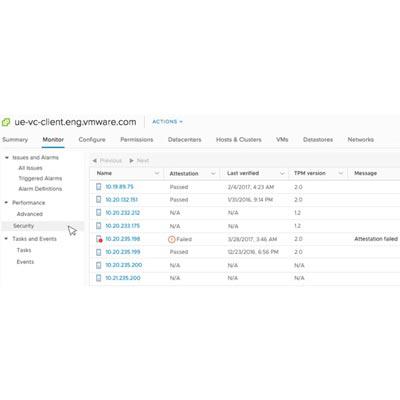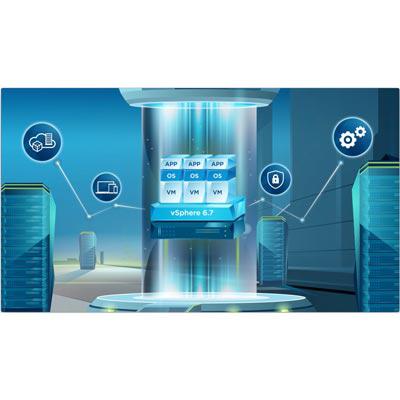7 Major VMware vSphere 6.7 Features That Partners Need To Know

A Universal Platform
VMware's vSphere is the industry's dominant solution for virtualizing infrastructure and building clouds. The platform powers small server racks, corporate data centers and public infrastructure providers, bringing to those diverse environment's VMware's vision for the software-defined data center.
The latest release, vSphere 6.7, continues an evolution of VMware's flagship product into the age of the cloud by introducing several capabilities to better connect and secure heterogenous environments.
With vSphere 6.7, which became generally available this week, the virtualization leader also aims to ease the administration of a wide variety of modern applications, including those built with cloud-native architectures and next-gen workloads like artificial intelligence and edge computing, said Himanshu Singh, group manager for vSphere product marketing, told CRN.
The following are some of the major features introduced in vSphere 6.7.

Hybrid Posture
The latest vSphere release makes it easier to connect on-premises clouds with those operated by VMware's Cloud Provider Program partners -- a group that includes regional and boutique operators, as well as industry giants like Amazon Web Services and IBM.
Customers are increasingly leveraging those public services while also expanding their private cloud footprints, including at the edge of their networks. They want a common operating environment across all that infrastructure.
"Hybrid cloud is becoming the de facto for the enterprise in terms of how they see their overall IT environment," Singh said. The 6.7 release advances the "seamless hybrid cloud experience for large vSphere environments."
A new feature called vCenter Hybrid Link Mode connects any vSphere-virtualized cloud, regardless of the version of the software. That allows enterprises to delay upgrades for on-premises environments while still leveraging public cloud services.
The release also introduces Cross-Cloud Cold and Hot Migration to make it easier to move data between clouds without operational disruption.

Modern Workload Support
VMware wants vSphere to be the premier environment for running all categories of enterprise workloads, both on-premises and across a spectrum of public cloud partners.
To achieve that, the virtualization platform introduced upgraded management features and hardware support required by modern applications such as artificial intelligence, machine learning, big data, business-critical, cloud-native, in-memory, and 3-D graphics.
Customers had asked VMware to address management and visibility challenges arising from the proliferation of apps -- both legacy and modern -- running in their data centers and public cloud environments, Singh said.
"We're continuing to make sure vSphere is the universal application platform for a variety of workloads, especially to support newer intelligent workloads," Singh said.

Security
The latest vSphere release builds on security features first introduced in vSphere 6.5, the last production release.
Trusted Platform Module (TPM) 2.0 upgrades a feature that protects the hypervisor, and Virtual TPM 2.0 uses the same technology to defend guest operating systems, preventing malicious actors from tampering with virtual machines.
VMware also simplified workflows to make it easier to encrypt virtual machines.
And for data moving across public and private environments, vSphere 6.7 enhances protection by enabling encrypted vMotion across different vCenter instances and versions.
"Customers can rest assured that data and applications are secure while moving across locations," Singh said.

GPU Enablement
Through a continuing partnership with Nvidia, VMware made it easier to leverage graphics processors for running artificial intelligence, machine learning and virtual desktop workloads.
New suspend and resume capabilities allow customers to use the same virtual GPUs for different workloads, Singh said. They can run virtual desktops during the day, and in off-hours transition those virtual machines to executing high performance computing applications.
"We've been working toward bringing the full vSphere experience to these GPUs," Singh said.

Persistent Memory
VMware worked with several hardware vendors to enable vSphere to support persistent memory -- the latest advance in solid-state data storage that can significantly speed system operations.
That new technology can be used as either block storage or as memory, Singh said.
"This gives customer a bunch of additional choice to swap out the underlying storage with persistent memory," Singh said. "You can get high performance at flash prices."
The performance gains are substantial.
VMware has metered applications seeing a 6X boost when swapping in persistent memory, Singh said.

Boosted Performance
The latest vSphere release delivers some substantial performance boosts from an upgraded vCenter Server Appliance that will save customers time and costs.
VMware evaluates its virtualization platform by clocking vCenter Operations Per Second.
Compared to 6.5, that metric has doubled with the latest release. VMware has also delivered a three-fold reduction in memory usage, and three-times faster operations related to its DRS (Distributed Resource Scheduler) by which clusters share resources and management, Singh said.
"When you start picking up larger environments across multiple locations, it's really key to have this kind of efficiency," Singh said.
The latest vCenter Server Appliance also improves the user experience with new APIs that introduce efficiencies when deploying the vSphere management application.

Enhanced Administrator Experience
VMware introduced other efficiencies to speed operations and make the work of IT administrators easier.
Among them, the 6.7 release eliminates one of the two reboots that are needed when patches or upgrades are installed.
To save even more time when updating software, a new option called vSphere Quick Boot allows users to skip some hardware initialization steps when they have specified third-party hardware, making the remaining reboot a shorter affair.
An enhanced vSphere Client also introduces new functionality to ease management of the NSX network virtualization solution, vSAN storage, and vSphere Update Manager. It also adds support for more third-party products.